Pearl S. Buck
Pearl Sydenstricker Buck | |
|---|---|
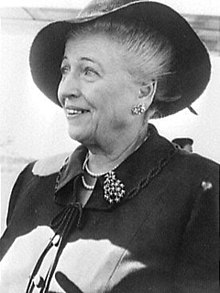 Pearl Buck, ca. 1972. | |
| Born | Pearl Sydenstricker (1892-06-26)June 26, 1892 Hillsboro, West Virginia, U.S. |
| Died | March 6, 1973(1973-03-06) (aged 80) Danby, Vermont, U.S. |
| Occupation | Writer, Teacher |
| Nationality | American |
| Subject | English |
| Notable awards | Pulitzer Prize 1932 Nobel Prize in Literature 1938 |
| Spouse | John Lossing Buck (1917–1935) Richard J. Walsh (1935–1960) until his death |
| Signature |  |
| Pearl S. Buck | |||||||||||
| Traditional Chinese | 賽珍珠 | ||||||||||
|---|---|---|---|---|---|---|---|---|---|---|---|
| Simplified Chinese | 赛珍珠 | ||||||||||
| Literal meaning | Precious Pearl | ||||||||||
| |||||||||||
Pearl Sydenstricker Buck (June 26, 1892 – March 6, 1973; also known by her Chinese name Sai Zhenzhu; Chinese: 賽珍珠) was an American writer and novelist. As the daughter of missionaries, Buck spent most of her life before 1934 in Zhenjiang, China. Her novel The Good Earth was the best-selling fiction book in the United States in 1931 and 1932 and won the Pulitzer Prize in 1932. In 1938, she was awarded the Nobel Prize in Literature "for her rich and truly epic descriptions of peasant life in China and for her biographical masterpieces".[1] She was the first American woman to win the Nobel Prize for Literature.
After returning to the United States in 1935, she continued writing prolifically, became a prominent advocate of the rights of women and minority groups, and wrote widely on Chinese and Asian cultures, becoming particularly well known for her efforts on behalf of Asian and mixed-race adoption.
Contents
1 Early life
2 Career in China
3 Career in the United States
4 Nobel Prize in Literature
5 Humanitarian efforts and later life
6 Final years
7 Legacy
8 Selected bibliography
8.1 Autobiographies
8.2 Biographies
8.3 Novels
8.4 Non-fiction
8.5 Short stories
9 Awards
10 Museums and historic houses
11 See also
12 Notes
13 Further reading
14 External links
Early life
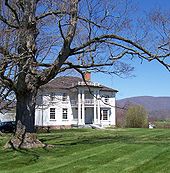
The Stulting House at the Pearl Buck Birthplace in Hillsboro, West Virginia
Originally named Comfort by her parents,[2] Pearl Sydenstricker was born in Hillsboro, West Virginia, to Caroline Maude (Stulting) (1857–1921) and Absalom Sydenstricker. Her parents, Southern Presbyterian missionaries, traveled to China soon after their marriage on July 8, 1880, but returned to the United States for Pearl's birth. When Pearl was five months old, the family arrived in China, first in Huai'an and then in 1896 moved to Zhenjiang (then often known as Jingjiang or, in the Chinese postal romanization system, Tsingkiang), near Nanking.[3]
Of her siblings who survived into adulthood, Edgar Sydenstricker had a distinguished career with the United States Public Health Service and later the Milbank Memorial Fund and Grace Sydenstricker Yaukey (1899–1994) was a writer who wrote young adult books and books about Asia under the pen name Cornelia Spencer.[4][5]

Chinese man in Zhenjiang, c. 1900
She recalled in her memoir that she lived in "several worlds", one a "small, white, clean Presbyterian world of my parents", and the other the "big, loving merry not-too-clean Chinese world", and there was no communication between them.[6] The Boxer Uprising greatly affected the family; their Chinese friends deserted them, and Western visitors decreased. Her father, convinced that no Chinese could wish him harm, stayed behind as the rest of the family went to Shanghai for safety. A few years later, Pearl was enrolled in Miss Jewell's School there, and was dismayed at the racist attitudes of the other students, few of whom could speak any Chinese. Both of her parents felt strongly that Chinese were their equals (they forbade the use of the word heathen), and she was raised in a bilingual environment: tutored in English by her mother, in the local dialect by her Chinese playmates, and in classical Chinese by a Chinese scholar named Mr. Kung. She also read voraciously, especially, in spite of her father's disapproval, the novels of Charles Dickens, which she later said she read through once a year for the rest of her life.[7]
In 1911, Pearl left China to attend Randolph-Macon Woman's College in Lynchburg, Virginia, in the United States, graduating Phi Beta Kappa in 1914 and a member of Kappa Delta Sorority. Although she had not intended to return to China, much less become a missionary, she quickly applied to the Presbyterian Board when her father wrote that her mother was seriously ill. From 1914 to 1932, she served as a Presbyterian missionary, but her views later became highly controversial during the Fundamentalist–Modernist Controversy, leading to her resignation.[8]
Career in China
In 1914, Pearl returned to China. She married an agricultural economist missionary, John Lossing Buck, on May 30, 1917, and they moved to Suzhou, Anhui Province, a small town on the Huai River (not to be confused with the better-known Suzhou in Jiangsu Province). This region she describes in her books The Good Earth and Sons.
From 1920 to 1933, the Bucks made their home in Nanjing, on the campus of the University of Nanking, where they both had teaching positions. She taught English literature at the private, church-run University of Nanking,[9]Ginling College and at the National Central University. In 1920, the Bucks had a daughter, Carol, afflicted with phenylketonuria. In 1921, Buck's mother died of a tropical disease, sprue, and shortly afterward her father moved in. In 1924, they left China for John Buck's year of sabbatical and returned to the United States for a short time, during which Pearl Buck earned her master's degree from Cornell University. In 1925, the Bucks adopted Janice (later surnamed Walsh). That autumn, they returned to China.[8]
The tragedies and dislocations that Buck suffered in the 1920s reached a climax in March 1927, during the "Nanking Incident". In a confused battle involving elements of Chiang Kai-shek's Nationalist troops, Communist forces, and assorted warlords, several Westerners were murdered. Since her father Absalom insisted, as he had in 1900 in the face of the Boxers, the family decided to stay in Nanjing until the battle reached the city. When violence broke out, a poor Chinese family invited them to hide in their hut while the family house was looted. The family spent a day terrified and in hiding, after which they were rescued by American gunboats. They traveled to Shanghai and then sailed to Japan, where they stayed for a year, after which they moved back to Nanjing. Buck later said that this year in Japan showed her that not all Japanese were militarists. When she returned from Japan in late 1927, Buck devoted herself in earnest to the vocation of writing. Friendly relations with prominent Chinese writers of the time, such as Xu Zhimo and Lin Yutang, encouraged her to think of herself as a professional writer. She wanted to fulfill the ambitions denied to her mother, but she also needed money to support herself if she left her marriage, which had become increasingly lonely, and since the mission board could not provide it, she also needed money for Carol's specialized care. Buck went once more to the States in 1929 to find long-term care for Carol, and while there, Richard J. Walsh, editor at John Day publishers in New York, accepted her novel East Wind: West Wind. She and Walsh began a relationship that would result in marriage and many years of professional teamwork. Back in Nanking, she retreated every morning to the attic of her university bungalow and within the year completed the manuscript for The Good Earth.[10]
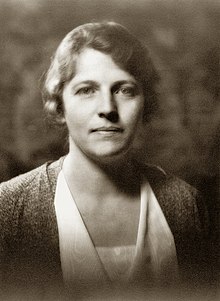
Pearl Buck in 1932, about the time The Good Earth was published.
Photo: Arnold Genthe
When John Lossing Buck took the family to Ithaca the next year, Pearl accepted an invitation to address a luncheon of Presbyterian women at the Astor Hotel in New York City. Her talk was titled "Is There a Case for the Foreign Missionary?" and her answer was a barely qualified "no". She told her American audience that she welcomed Chinese to share her Christian faith, but argued that China did not need an institutional church dominated by missionaries who were too often ignorant of China and arrogant in their attempts to control it. When the talk was published in Harper's magazine,[11] the scandalized reaction led Buck to resign her position with the Presbyterian Board. In 1934, Buck left China, believing she would return,[12] while John Lossing Buck remained.[13]
Career in the United States
In 1935 the Bucks divorced in Reno, Nevada,[14] and she married Richard Walsh that same day.[12] He offered her advice and affection which, her biographer concludes, "helped make Pearl's prodigious activity possible". The couple lived in Pennsylvania until his death in 1960.[10]
During the Cultural Revolution, Buck, as a preeminent American writer of Chinese village life, was denounced as an "American cultural imperialist".[15] Buck was "heartbroken" when she was prevented from visiting China with Richard Nixon in 1972. Her 1962 novel Satan Never Sleeps described the Communist tyranny in China. Following the Communist Revolution in 1949, Buck was repeatedly refused all attempts to return to her beloved China and therefore was compelled to remain in the United States for the rest of her life.[12]
Pearl S. Buck died of lung cancer on March 6, 1973, in Danby, Vermont, and was interred in Green Hills Farm in Perkasie, Pennsylvania. She designed her own tombstone. Her name was not inscribed in English on her tombstone. Instead, the grave marker is inscribed with Chinese characters representing the name Pearl Sydenstricker.[16]
Nobel Prize in Literature
In 1938 the Nobel Prize committee in awarding the prize said:
.mw-parser-output .templatequote{overflow:hidden;margin:1em 0;padding:0 40px}.mw-parser-output .templatequote .templatequotecite{line-height:1.5em;text-align:left;padding-left:1.6em;margin-top:0}
By awarding this year's Prize to Pearl Buck for the notable works which pave the way to a human sympathy passing over widely separated racial boundaries and for the studies of human ideals which are a great and living art of portraiture, the Swedish Academy feels that it acts in harmony and accord with the aim of Alfred Nobel's dreams for the future.[17]
In her speech to the Academy, she took as her topic "The Chinese Novel." She explained, "I am an American by birth and by ancestry", but "my earliest knowledge of story, of how to tell and write stories, came to me in China." After an extensive discussion of classic Chinese novels, especially Romance of the Three Kingdoms, All Men Are Brothers, and Dream of the Red Chamber, she concluded that in China "the novelist did not have the task of creating art but of speaking to the people." Her own ambition, she continued, had not been trained toward "the beauty of letters or the grace of art." In China, the task of the novelist differed from the Western artist: "To farmers he must talk of their land, and to old men he must speak of peace, and to old women he must tell of their children, and to young men and women he must speak of each other." And like the Chinese novelist, she concluded, "I have been taught to want to write for these people. If they are reading their magazines by the million, then I want my stories there rather than in magazines read only by a few."[18]
Humanitarian efforts and later life

1983 U.S. commemorative stamp from the Great Americans series honoring Buck.
Buck was highly committed to a range of issues that were largely ignored by her generation. Many of her life experiences and political views are described in her novels, short stories, fiction, children's stories, and the biographies of her parents entitled Fighting Angel (on Absalom) and The Exile (on Carrie). She wrote on diverse subjects, including women's rights, Asian cultures, immigration, adoption, missionary work, war, the atomic bomb (Command the Morning), and violence.
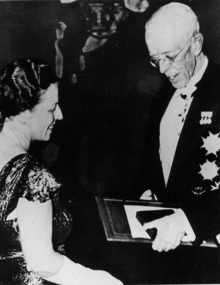
Pearl S. Buck is receiving the Nobel Prize for Literature from King Gustav V of Sweden in the Stockholm Concert Hall in 1938.
She was involved in the charity relief campaign for the victims of the 1931 China floods, writing a series of short stories describing the plight of refugees, which were broadcast on the radio in the United States and later published in her collected volume The First Wife and Other Stories.[19] In 1949, outraged that existing adoption services considered Asian and mixed-race children unadoptable, Buck co-founded Welcome House, Inc.,[20] the first international, interracial adoption agency, along with James A. Michener, Oscar Hammerstein II and his second wife Dorothy Hammerstein. In nearly five decades of work, Welcome House has placed over five thousand children. In 1964, to support kids who were not eligible for adoption, Buck established the Pearl S. Buck Foundation (name changed to Pearl S. Buck International in 1999)[21] to "address poverty and discrimination faced by children in Asian countries". In 1964, she opened the Opportunity Center and Orphanage in South Korea, and later offices were opened in Thailand, the Philippines, and Vietnam. When establishing Opportunity House, Buck said, "The purpose ... is to publicize and eliminate injustices and prejudices suffered by children, who, because of their birth, are not permitted to enjoy the educational, social, economic and civil privileges normally accorded to children."[22]
In 1960, after a long decline in health, her husband Richard died. She renewed a warm relation with William Ernest Hocking, who died in 1966. Buck then withdrew from many of her old friends and quarreled with others. In 1962 Buck asked the Israeli Government for clemency for Adolf Eichmann, the Nazi War Criminal that was complicit in the deaths of five million Jews during WWII. (Cesarani 2005, pp. 319–320). In the late 1960s, Buck toured West Virginia to raise money to preserve her family farm in Hillsboro, West Virginia. Today The Pearl S. Buck Birthplace is a historic house museum and cultural center.[23] She hoped the house would "belong to everyone who cares to go there", and serve as a "gateway to new thoughts and dreams and ways of life".[24]
Long before it was considered fashionable or politically safe to do so, Buck challenged the American public by raising consciousness on topics such as racism, sex discrimination and the plight of Asian war children. During her life, Buck combined the careers of wife, mother, author, editor, international spokesperson, and political activist.[25]
Final years
In the mid 1960s, Buck increasingly came under the influence of Theodore Harris, a former dance instructor, who became her confidant, co-author, and financial advisor. She soon depended on him for all her daily routines, and placed him in control of Welcome House and the Pearl S. Buck Foundation. Harris, who was given a lifetime salary as head of the foundation, created a scandal for Buck when he was accused of mismanaging the foundation, diverting large amounts of the foundation's funds for his friends' and his own personal expenses, and treating staff poorly.[26][27] Buck defended Harris, stating that he was "very brilliant, very high strung and artistic".[26] Before her death Buck signed over her foreign royalties and her personal possessions to Creativity Inc., a foundation controlled by Harris, leaving her children a relatively small percentage of her estate.[28]
Buck died on March 6, 1973, from lung cancer. After her death, Buck's children contested the will and accused Harris of exerting "undue influence" on Buck during the last few years. Harris failed to appear at trial and the court ruled in the family's favor.[27][29]
Legacy

Pearl S. Buck's former residence at Nanjing University

A statue of Pearl S. Buck stands in front of the former residence at Nanjing University
Many contemporary reviewers were positive and praised her "beautiful prose", even though her "style is apt to degenerate into over-repetition and confusion".[30]Robert Benchley wrote a parody of The Good Earth that focused on just these qualities. Peter Conn, in his biography of Buck, argues that despite the accolades awarded to her, Buck's contribution to literature has been mostly forgotten or deliberately ignored by America's cultural gatekeepers.[31] Kang Liao argues that Buck played a "pioneering role in demythologizing China and the Chinese people in the American mind".[32]Phyllis Bentley, in an overview of Buck's work published in 1935, was altogether impressed: "But we may say at least that for the interest of her chosen material, the sustained high level of her technical skill, and the frequent universality of her conceptions, Mrs. Buck is entitled to take rank as a considerable artist. To read her novels is to gain not merely knowledge of China but wisdom about life."[33] These works aroused considerable popular sympathy for China, and helped foment poor relations with Japan.
Chinese-American author Anchee Min said she "broke down and sobbed" after reading The Good Earth for the first time as an adult, which she had been forbidden to read growing up in China during the Cultural Revolution. Min said Buck portrayed the Chinese peasants "with such love, affection and humanity" and it inspired Min's novel Pearl of China (2010), a fictional biography about Buck.[34]
In 1973, Buck was inducted into the National Women's Hall of Fame.[35] Buck was honored in 1983 with a 5¢ Great Americans series postage stamp issued by the United States Postal Service[36] In 1999 she was designated a Women's History Month Honoree by the National Women's History Project.[37]
Buck's former residence at Nanjing University (赛珍珠故居) is now the Sai Zhenzhu Memorial House along the West Wall of the university's north campus. U.S. President George H. W. Bush toured the Pearl S. Buck House in October 1998. He expressed that he, like millions of other Americans, had gained an appreciation for the Chinese people through Buck's writing.[38]
Pearl Buck's papers and literary manuscripts are currently housed at Pearl S. Buck International[39] and the West Virginia & Regional History Center.[40]
Selected bibliography
Autobiographies
My Several Worlds: A Personal Record (New York: John Day, 1954).
A Bridge For Passing (New York: John Day, 1962)
Biographies
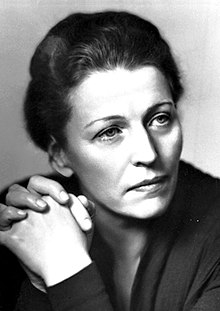
Pearl Buck
The Exile (1936)
Fighting Angel (1936)
Novels
East Wind:West Wind (1930)[41]
The House of Earth
The Good Earth (1931)
Sons (1933)
A House Divided (1935)
The Young Revolutionist (1932)
The Mother (1933)
All Men Are Brothers (1933), a translation of the Chinese classical prose epic Water Margin.
This Proud Heart (1938)
The Patriot (1939)
Other Gods (1940)
China Sky (1941)
Dragon Seed (1942)
The Promise (1943)
China Flight (1943)
The Townsman (1945) – as John Sedges
Portrait of a Marriage (1945)
Pavilion of Women (1946)
The Angry Wife (1947) – as John Sedges
Peony (1948)
The Big Wave (1948)
The Long Love (1949) – as John Sedges
The Bondmaid (1949), first published in Great Britain
Kinfolk (1950)
God's Men (1951)
The Hidden Flower (1952)
Come, My Beloved (1953)
Voices in the House (1953) – as John Sedges
The Beech Tree (1954) A Children's story
Imperial Woman (1956)
Letter from Peking (1957)
Command the Morning (1959)
Satan Never Sleeps (1962; see 1962 film Satan Never Sleeps)
The Living Reed (1963)
Death in the Castle (1965)
The Time Is Noon (1966)
Matthew, Mark, Luke and John (1967)
The New Year (1968)
The Three Daughters of Madame Liang (1969)
Mandala (1970)
The Goddess Abides (1972)
All Under Heaven (1973)
The Rainbow (1974)
The Eternal Wonder, (believed to have been written shortly before her death, published in October 2013)[42]
Non-fiction
Is There a Case for Foreign Missions? (New York: John Day, 1932).
The Chinese Novel: Nobel Lecture Delivered before the Swedish Academy at Stockholm, December 12, 1938 (New York: John Day, 1939).
Of Men and Women (1941)
What America Means to Me (New York: John Day, 1943). Essays.
Talk about Russia (with Masha Scott) (1945)
Tell the People: Talks with James Yen About the Mass Education Movement (New York: John Day, 1945).
How It Happens: Talk about the German People, 1914–1933, with Erna von Pustau (1947)- with Eslanda Goode Robeson. American Argument (New York: John Day, 1949).
The Child Who Never Grew (1950)
The Man Who Changed China: The Story of Sun Yat-sen (1953)
For Spacious Skies (1966)
The People of Japan (1966)
To My Daughters, With Love (1967)
The Kennedy Women (1970)
China as I See It (1970)
The Story Bible (1971)
Pearl S. Buck's Oriental Cookbook (1972)- "Words of Love" (1974)[43]
Short stories
The First Wife and Other Stories (1933)
Today and Forever: Stories of China (1941)
Twenty-Seven Stories (1943)
Far and Near: Stories of Japan, China, and America (1949)- "A Certain Star" (1957)
- "Christmas Miniature" (1958, illustrated by Anna Marie Magagna)
- "Christmas Ghost" (1961, illustrated by Anna Marie Magagna)
Fourteen Stories (1961)
Portrait of a Marriage (1961)
Hearts Come Home and Other Stories (1962)
Stories of China (1964)
Escape at Midnight and Other Stories (1964)
The Good Deed (1969)
Once Upon a Christmas (1972)
East and West Stories (1975)
Secrets of the Heart: Stories (1976)
The Lovers and Other Stories (1977)
Mrs. Stoner and the Sea and Other Stories (1978)
The Woman Who Was Changed and Other Stories (1979)- "Christmas Day in the Morning"
- "The Refugee"
- "The Chinese Children Next Door" (for children)
- ″The Enemy"
- "The Frill"
- "The Golden Flower"
- "The Old Demon"
Awards
Pulitzer Prize for the Novel: The Good Earth (1932)
William Dean Howells Medal (1935)
Nobel Prize in Literature (1938)
Museums and historic houses

Pearl S. Buck's study in Lushan Pearl S. Buck Villa
Several historic sites work to preserve and display artifacts from Pearl's profoundly multicultural life:
The Pearl S. Buck Birthplace in Hillsboro, West Virginia
Green Hills Farm in Bucks County, Pennsylvania
- The Zhenjiang Pearl S. Buck Research Association in Zhenjiang, China [3]
- Pearl S. Buck House in Nanjing University, China [4]
- The Pearl S. Buck Summer Villa, on Lushan Mountain in Jiangxi Province, China
- The Pearl S. Buck Memorial Hall, Bucheon City, South Korea[44]
Pearl S. Buck International, 520 Dublin Road, Perkasie, PA 18944 USA,215-249-0100
See also
- Christian feminism
- List of female Nobel laureates
Notes
^ The Nobel Prize in Literature 1938 Accessed 9 Mar 2013
^ Lian Xi, The Conversion of Missionaries, University Park, PA: Penn State University Press, 1996) 102 .mw-parser-output cite.citation{font-style:inherit}.mw-parser-output .citation q{quotes:"""""""'""'"}.mw-parser-output .citation .cs1-lock-free a{background:url("//upload.wikimedia.org/wikipedia/commons/thumb/6/65/Lock-green.svg/9px-Lock-green.svg.png")no-repeat;background-position:right .1em center}.mw-parser-output .citation .cs1-lock-limited a,.mw-parser-output .citation .cs1-lock-registration a{background:url("//upload.wikimedia.org/wikipedia/commons/thumb/d/d6/Lock-gray-alt-2.svg/9px-Lock-gray-alt-2.svg.png")no-repeat;background-position:right .1em center}.mw-parser-output .citation .cs1-lock-subscription a{background:url("//upload.wikimedia.org/wikipedia/commons/thumb/a/aa/Lock-red-alt-2.svg/9px-Lock-red-alt-2.svg.png")no-repeat;background-position:right .1em center}.mw-parser-output .cs1-subscription,.mw-parser-output .cs1-registration{color:#555}.mw-parser-output .cs1-subscription span,.mw-parser-output .cs1-registration span{border-bottom:1px dotted;cursor:help}.mw-parser-output .cs1-ws-icon a{background:url("//upload.wikimedia.org/wikipedia/commons/thumb/4/4c/Wikisource-logo.svg/12px-Wikisource-logo.svg.png")no-repeat;background-position:right .1em center}.mw-parser-output code.cs1-code{color:inherit;background:inherit;border:inherit;padding:inherit}.mw-parser-output .cs1-hidden-error{display:none;font-size:100%}.mw-parser-output .cs1-visible-error{font-size:100%}.mw-parser-output .cs1-maint{display:none;color:#33aa33;margin-left:0.3em}.mw-parser-output .cs1-subscription,.mw-parser-output .cs1-registration,.mw-parser-output .cs1-format{font-size:95%}.mw-parser-output .cs1-kern-left,.mw-parser-output .cs1-kern-wl-left{padding-left:0.2em}.mw-parser-output .cs1-kern-right,.mw-parser-output .cs1-kern-wl-right{padding-right:0.2em}
ISBN 0271064382.
^ Shavit, David (1990), The United States in Asia: a historical dictionary, Greenwood Publishing Group, p. 480, ISBN 0-313-26788-X (Entry for "Sydenstricker, Absalom")
^ "Grace Sydenstricker Yaukey papers, 1934-1968". Orbis Cascade Alliance. Retrieved 17 January 2019.
^ "Grace S. Yaukey Dies". Washington Post. May 5, 1994. Retrieved January 18, 2019.
^ Pearl S. Buck, My Several Worlds: A Personal Record (New York: John Day, 1954)p. 10.
^ Peter Conn, Pearl S. Buck: A Cultural Biography, Cambridge: Cambridge UP, 1996) 9, 19–23
ISBN 0521560802.
^ ab Conn, Pearl S. Buck, 70–82.
^ Gould Hunter Thomas (1 January 2004). "Nanking". An American in China, 1936-1939: A Memoir. Greatrix Press. ISBN 978-0-9758800-0-5.
^ ab Conn, Pearl S. Buck, 345.
^ Pearl S. Buck, "Is There a Case for Foreign Missions?," Harper's 166 (January 1933): 143-155.
^ abc Melvin, Sheila (2006). "The Resurrection of Pearl Buck". Wilson Quarterly Archives. Retrieved 2016-10-24.
^ Buck, Pearl S. The Good Earth. Ed. Peter Conn. New York: Washington Square Press, 1994. Pp. xviii–xix.
^ "Pearl Buck's divorce". renodivorcehistory.org. Retrieved 2015-10-15.
^ "A Chinese Fan Of Pearl S. Buck Returns The Favor". NPR. April 7, 2010.
^ Conn, Peter, Dragon and the Pearl
^ Presentation Speech by Per Hallström Permanent Secretary of the Swedish Academy, December 10, 1938 [1] Accessed 9 Mar 2013
^ Nobel Lecture (1938) The Chinese Novel
^ Courtney, Chris (2018), "The Nature of Disaster in China: The 1931 Central China Flood", Cambridge University Press [
ISBN 978-1-108-41777-8]
^ "Welcome House: A Historical Perspective". Pearl S. Buck International. Archived from the original on 2015-04-02. Retrieved 2015-04-06.
^ amy.gress. "Home". Pearl S Buck. Retrieved 2019-02-25.
^ Pearl S. Buck International, "Our History Archived 2006-12-31 at the Wayback Machine," 2009.
^ The Pearl S. Buck Birthplace Foundation
^ Buck, Pearl S. My Mother's House. Richwood, WV: Appalachian Press. pp. 30–31.
^ Conn, Pearl S. Buck, xv–xvi.
^ ab Walter, Greg (1991), "'Philadelphia', as quoted", in Sam G. Riley, Gary W. Selnow, Regional Interest Magazines of the United States, Westport, Connecticut: Greenwood Publishing Group, p. 259CS1 maint: Uses editors parameter (link)
^ ab Conn (1996), p. 376.
^ "Crumbling Foundation". TIME. 94 (4). 25 July 1969. p. 66.
^ "Overturning of Buck Will Seen as a Product of Passion". Lewiston Daily Sun. August 10, 1974. p. 9.
^ E.G. (1933). "Rev. of Sons". Pacific Affairs. 6 (2/3): 112–15. doi:10.2307/2750834.
^ Conn, Pearl S. Buck, xii–xiv.
^ Liao, Kang (1997). Pearl S. Buck: a cultural bridge across the Pacific. Greenwood. p. 4. ISBN 978-0-313-30146-9.
^ Bentley, Phyllis (1935). "The Art of Pearl S. Buck". The English Journal. 24 (10): 791–800. JSTOR 804849.
^ NPR, "A Chinese Fan Of Pearl S. Buck Returns The Favor", All Things Considered, April 7, 2010. Accessed 7/4/10
^ National Women's Hall of Fame, Pearl S. Buck
^ Smithsonian National Postal Museum. "Great Americans Issue: 5-cent Buck". Retrieved 14 August 2013.
^ "Honorees: 2010 National Women's History Month". Women's History Month. National Women's History Project. 2010. Retrieved 14 November 2011.
^ DDMap.com: 赛珍珠故居 (in Chinese), archived from the original on 2015-04-02, retrieved 2010-02-21
^ Pearl S. Buck International: House Archives, retrieved 2016-10-24
^ Pearl S. Buck Collection: About the Collection, retrieved 2016-10-24
^ "East Wind: West Wind by Pearl S Buck". Fantasticfiction. Retrieved 2015-04-06.
^ Julie Bosman (21 May 2013). "A Pearl Buck Novel, New After 4 Decades". New York Times.
^ [2]
^ "Pearl S. Buck International: Other Pearl S. Buck Historic Places". Psbi.org. 2006-09-30. Archived from the original on 2011-07-19. Retrieved 2010-02-25.
Further reading
Conn, Peter J. (1996), Pearl S. Buck: A Cultural Biography, Cambridge England; New York: Cambridge University Press, ISBN 0521560802
- Hilary Spurling, Burying the Bones: Pearl Buck in China (London: Profile, 2010)
ISBN 9781861978288
- Nora B. Stirling, Pearl Buck, a Woman in Conflict (Piscataway, NJ: New Century Publishers, 1983)
- Elizabeth Johnston Lipscomb, Frances E. Webb and Peter J. Conn, eds., The Several Worlds of Pearl S. Buck: Essays Presented at a Centennial Symposium, Randolph-Macon Woman's College, March 26–28, 1992. Westport, CT: Greenwood Press, Contributions in Women's Studies, 1994.
ISBN 0313291527
- Liao Kang. Pearl S. Buck: A Cultural Bridge across the Pacific. (Westport, CT, London: Greenwood, Contributions to the Study of World Literature 77, 1997).
ISBN 0-313-30146-8. - Xi Lian. The Conversion of Missionaries: Liberalism in American Protestant Missions in China, 1907-1932. (University Park: Pennsylvania State University Press, 1997).
ISBN 027101606X
Roan, Jeanette (2010). "Knowing China: Accuracy, Authenticity and The Good Earth". Envisioning Asia: On Location, Travel, and the Cinematic Geography of U.S. Orientalism. Ann Arbor, Michigan: University of Michigan Press. pp. 113–55. ISBN 0-472-05083-4. OCLC 671655107 – via Project MUSE. (Subscription required (help)).
Mari Yoshihara. Embracing the East: White Women and American Orientalism. (New York: Oxford University Press, 2003).
ISBN 019514533X
- Karen J. Leong. The China Mystique: Pearl S. Buck, Anna May Wong, Mayling Soong, and the Transformation of American Orientalism (Berkeley: University of California Press, 2005).
ISBN 0520244222
- Theodore F. Harris (in consultation with Pearl S. Buck), Pearl S. Buck: a Biography (John Day, June 1969.
ISBN 978-0-381-98113-6) - Theodore F. Harris (in consultation with Pearl S. Buck), Pearl S. Buck; a biography. Volume two: Her philosophy as expressed in her letters (John Day, January 1971. ASIN B002BAA2PU)
External links
| Wikiquote has quotations related to: Pearl S. Buck |
| Wikimedia Commons has media related to Pearl S. Buck. |
- Pearl S. Buck fuller bibliography at WorldCat
- The Pearl S. Buck Birthplace in Pocahontas County West Virginia
- Pearl S. Buck International
The Zhenjiang Pearl S. Buck Research Association, China (in Chinese & English)- Official Nobel Prize Website: Brief Biography
- University of Pennsylvania website dedicated to Pearl S. Buck
- Petri Liukkonen. "Pearl S. Buck". Books and Writers
Pearl S. Buck on IMDb- National Trust for Historic Preservation on the Pearl S. Buck House Restoration
Pearl Buck interviewed by Mike Wallace on The Mike Wallace Interview February 8, 1958
"Pearl S. Buck 5 cent issue". Great Americans series. Smithsonian Institution National Postal Museum. Retrieved 10 March 2012.
Pearl S. Buck at Find a Grave
- The Pearl S. Buck Literary Manuscripts and Other Collections at the West Virginia & Regional History Collection, WVU Libraries
FBI Records: The Vault - Pearl Buck at fbi.gov- Spring, Kelly. "Pearl Buck". National Women's History Museum.
Presentation by Peter Conn on Pearl S. Buck: A Cultural Biography, March 5, 1997, C-SPAN
